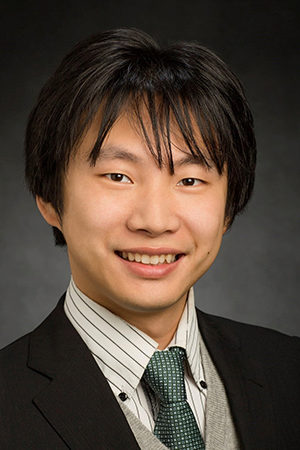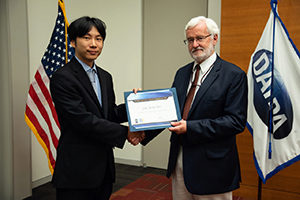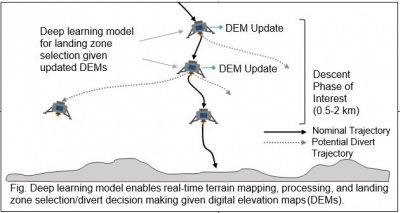 |
| Prof. Koki Ho |
The Daniel Guggenheim School's space program has received a huge boost with the recent arrival of Prof. Koki Ho, an assistant professor and head of the newly formed Space Systems Optimization Group (SSOG).*
Under the auspices of a Defense Advanced Research Projects Agency (DARPA) Young Faculty Award and a NASA Early Career Faculty Award, Ho is diving into two projects that seek to employ automated optimization techniques to improve space systems in two different scenarios.
"What my group does is the probabilistic modeling and simulation associated with optimization for space applications. I would like to expand the role of optimization in mission design," said Ho.
"Traditionally, space mission design involves a lot of human-in-the-loop contributions, and we will still need that, of course, because there's no way to replace the creativity and the big ideas. But there are bigger roles that optimization and machine learning techniques can play in space mission design practice. More than just fine-tuning. They can be decision-support tools. I want to push that trend."
DARPA: Time-Expanded Space Logistics Network Modeling and Optimization for On-Orbit Servicing, Assembly, and Manufacturing (OSAM)
The $500,000 DARPA Young Faculty Award will allow Ho to use a network-based simulation concept to optimize logistics design for on-orbit, servicing, assembly, and manufacturing (OSAM) missions. These so-called OSAM missions will become critical, he notes, as space exploration increasingly depends on the deployment of reusable assets --refueling, maintenance, and operational infrastructure -- to accomplish more complicated, long-term missions.
"If you are trying to land on the moon, you have more of a trajectory problem," he said. "But if you are trying to service a problem on a satellite, it is more complex. We are creating an optimization method for planning and scheduling of those servicing missions."
Ho said his research introduces a new perspective to space mission planning, one that borrows from the network-based terrestrial logistics used by Amazon and FedEx. On the ground, he says, transportation is seen as movement between a network of nodes - cities, transportation hubs, trains, cars, trucks. To move packages from one place to another, they optimize the travel between those points in a network. Though the terrain and environment are different, this approach can be adopted to space travel, he said.
 |
| Prof. Koki Ho is seen here accepting his Young Faculty Award from DARPA program manager Dr. Michael Fiddy |
"With traditional space missions, like Apollo, we looked at mission design as a trajectory problems. So when we sent Apollo to the moon, we put everything in a rocket and sent it there and then it came back. When we design missions in the future, we need to plan multiple missions -- ones that consider the OSAM needs of our re-usable assets. Each mission has different goals - to deploy, to set-up, to use, to refuel, for instance - and those all require unique analysis and need to be optimized altogether. To ensure mission success, each asset needs to be at the right place at the right time."
Ho's said he looks at the orbits of all assets – for example, different locations of the satellites that need servicing – as nodes in that network. He uses this to simulate missions that will allow an efficient flow of commodities – satellite modules, spares, equipment, fuel, etc - over time.
"Those commodities will interact with one another, constraining each other, over time, so we need to incorporate this into the model," he said. "We call it dynamic multi-commodity network flow because it looks at how things change over time, and that will be important as we look at on-orbit servicing of satellites in space."
NASA: Real-Time Terrain Mapping and Processing for Safe Landing via Deep Neural Networks
Under the auspices of a three-year $600,000 Early Career grant from NASA, Ho's research group will develop new approaches to safely, accurately, and efficiently land space vehicles in uncertain environments.
"We cannot fully design this on the ground because we don't entirely know the nature of the terrain until we get there," Ho says of the problem. "So we need to be able to make adjustments in real-time."
The traditional approach for real-time landing site decision is to use simple decision rules based on local terrain features such as slopes and roughness obtained form the camera or Light Detection and Ranging (LiDAR), a remote sensing method that uses lasers to measure variable distances. However, little research has focused on algorithms for selection of safe landing zones with system-level parameters and uncertainties in consideration.
 |
"So what I proposed was to develop new machine learning models and methods so we can collect new information in real-time and use it to confirm the safety of a proposed landing or to divert the landing path. This involves machine learning and optimization, and it is for real-time onboard applications, which has different challenges than the design optimization research we used in the DARPA project.”
The algorithms currently used to select safe landing zones employ digitized elevation maps (DEM) to identify terrain features. Ho proposes using an integrated systems-based approach that will employ a novel deep-learning-based framework. This will enable the onboard algorithms to quickly detect hazards and identify safe landing zones with inflight diversion maneuvers.
*Professor Ho works within the AE School's Space Systems Design Lab, which encompasses several of the space-related research programs pursued by AE faculty.